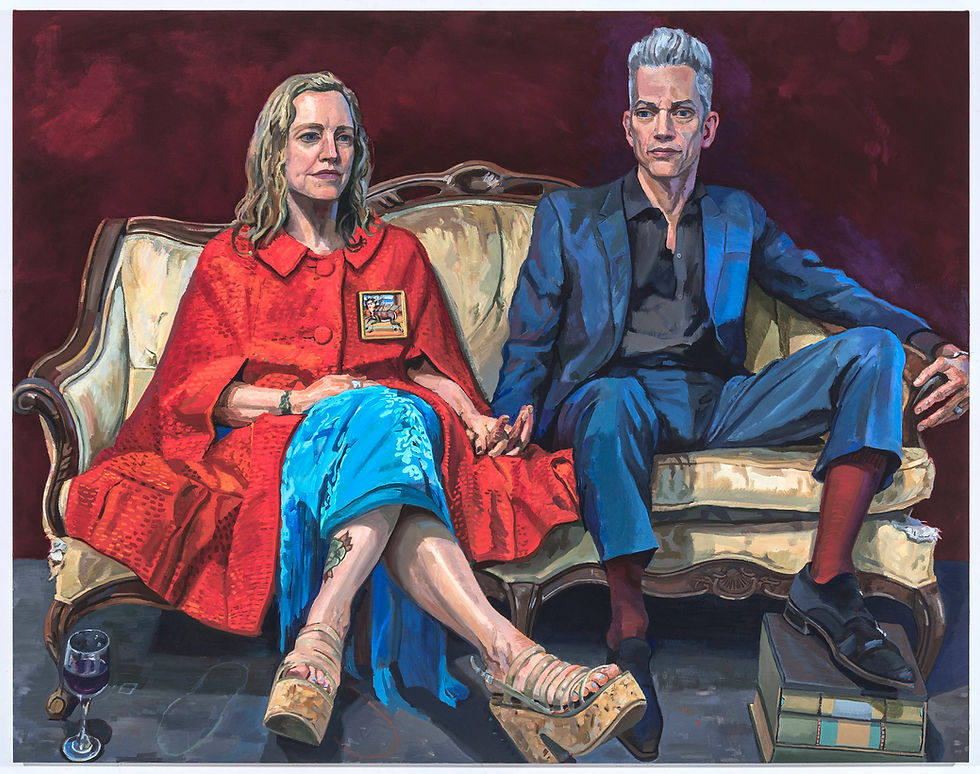Brian Alfred
- johnwilliammitchel
- Sep 28, 2023
- 4 min read
It’s another unseasonably warm winter day in NYC - Tuesday February 13th, early evening and dark out. It’ll be in the 50’s tomorrow and in the 60’s the day after. I’m trying to remember if I’ve ever experienced such a warm February in NYC.
There’s an unsettling mist and fog in the air as I weave through end of the day rush hour hordes of people – many bumping into each other as they walk with illuminated faces absorbed in their handheld screens. The pedestrian crowd dissipates as I walk through Chelsea and finally step into Miles McEnery Gallery to meet up with artist Brian Alfred for a look and talk about his current one-person show of 15 paintings and 1 animated video projection.
How did you come up with your exhibition title and at what point in the process of making this body of work did you decide “Future Shock” was it?
As I was making the new body of work and thinking about the environment and issues around changes and how they affect our landscape, I came across the Toffler book Future Shock and was amazed at how even though it was written almost fifty years ago, it's just as relevant today. There were connecting themes and ideas to the imagery I was thinking about and that's when I decided to title it that. I also love the Herbie Hancock record of the same name. He was using technology in his music and was so inventive in that process. It was like the flip side of what technology can do for people.
What do you mean by Herbie Hancock’s use of technology being like the flip side of what technology can do for people? How do you use technology in your work?
Well, in Future Shock, there is a warning that all the technology we are developing and surrounding ourselves with will become too rapid and difficult to cope with. It will become problematic. Herbie embraced technology with involving it in his music and used it to push his music into new directions - a more optimistic approach to technology's value. I like this duality. I feel that same duality in my work. I use technology to make my work in different ways, yet much of the subject matter is a wariness about the effects that development and industrialization have on our world.
You have a studio in Brooklyn and one in Pennsylvania plus you said that you’re able to do some work at home. Did you make some of this work in Brooklyn and some in Pennsylvania? Why two studios and what are they like? What work are you able to do at home?
Yes, I made the work for this show across all three. I tend to make smaller work and animations at home, the rest in the studios proper. My studios are pretty similar, not too big, cozy, lots of music and coffee and paint. All I really need is a white wall, coffee and music and I’m ready.
How do you make one of these paintings? Where do you get the stretchers? Do you stretch your paintings yourself? Priming? Then how does a painting start? Do you draw on the surface first or go right in with paint?
I make a stretcher (or panel if the work is smaller) and stretch it with canvas, about 4 to 6 coats of gesso sanded and I’m ready to go. Some paintings are improvised, some use a photo as a base and some are projected drawings sketched out on the canvas. I use acrylic paint and I use foam brushes, regular brushes, tape, x-acto's, and occasionally an airbrush, although rare. Each painting and image dictates how I need to physically paint them. For instance, a building will have more flat edges, tape, clean lines. A forest will be looser and more organic.
How about the animated videos? How do you make those?
I make the animations in After Effects usually. I use painting images, scanned collage and drawings made on the computer and put them into motion. I often collaborate with musicians on the sound for the piece. Sometimes I make the animation to an existing song made by a musician who created a track in relation to a series of images I’ve shared with them. Other times it’s a back and forth process of me animating to sounds provided and the musician tweaking it to fit the animation better. It’s great to collaborate with musicians as it adds a completely different feel to the creative process. The animations take me weeks to months, much longer than the paintings do.
You were in a touring band in the late 90’s and early 00’s. You make collage works, prints, paintings, animated videos, and in 2016 you launched a podcast called “Sound & Vision” in which you talk to other artists one on one. Talk about your multimedia approach to making things and the benefits of these different ways of working.
I came to all of these ways of working and projects organically. I keep open to new ways of working, new experiences and new opportunities to connect. I really feel that art-making is communicating and I have realized the benefit of broadening that communication into different avenues. To be able to spend
my life creating things and surrounding myself with creative people is a real gift. For me, the diverse ways of being creative make my work more interesting and keep me interested in making. Be it music, conversations, collaborations, I love all the opportunities I have been afforded.


























Brian Alfred's exhibition "Future Shock" runs through March 10th at Miles McEnery Gallery, 524 W. 19th Street, NY, NY.




Comments